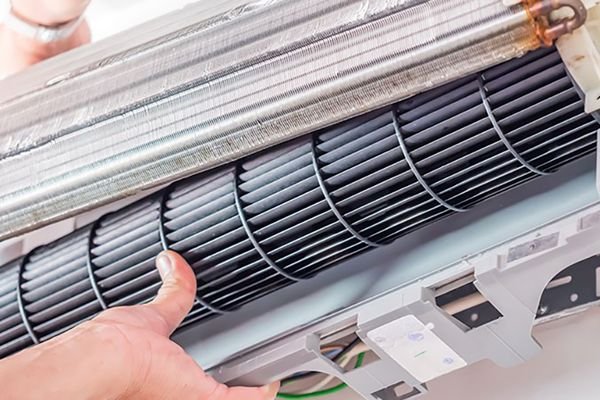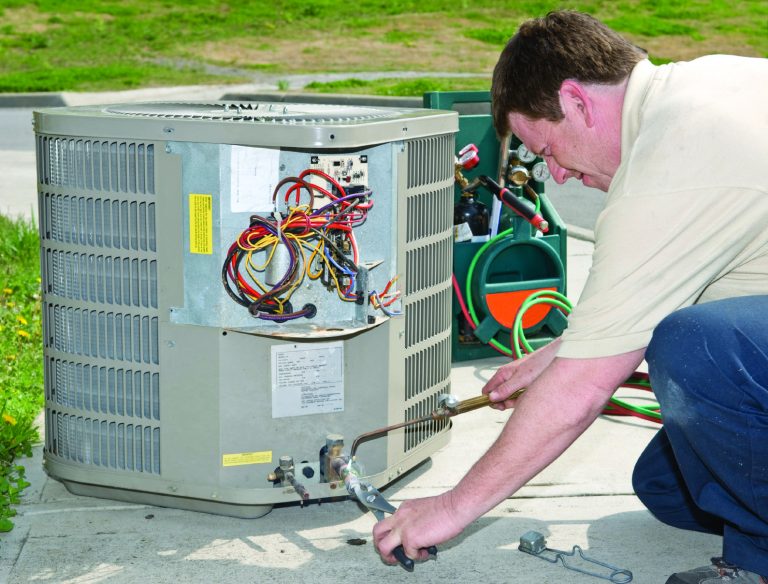How Does Auto Air Conditioning Work? Discover The Secrets Behind Efficient Cooling Systems
Auto air conditioning works by using a complex system of components to cool the air inside a car. Here is a summary of how it works: 1. Compressor: The compressor pressurizes the refrigerant gas, raising its temperature. 2. Condenser: The hot, pressurized gas flows through the condenser, where it releases heat and becomes a high-pressure liquid. 3. Expansion Valve: The expansion valve regulates the flow of the high-pressure liquid refrigerant into the evaporator. 4. Evaporator: As the liquid refrigerant passes through the evaporator, it absorbs heat from the air inside the car, cooling it down. 5. Blower Fan: The blower fan blows the cooled air into the car’s cabin. 6. Refrigerant Cycle: The refrigerant, now in a low-pressure gaseous state, returns to the compressor to start the cycle again. Understanding how auto air conditioning works can help troubleshoot problems and optimize the cooling system’s performance.
In the sweltering heat of summer, there’s nothing more blissful than stepping into a cool, air-conditioned car. But have you ever wondered about the magic behind that refreshing burst of cool air? How does auto air conditioning work, and what are the secrets behind efficient cooling systems? Delving into this topic not only satisfies your curiosity, but it also equips you with knowledge that can help optimize your vehicle’s performance.
Auto air conditioning is a wondrous blend of science and engineering that ensures your car remains a comfortable oasis, even on the hottest of days. Forget about the image of a simple fan blowing air through vents; modern-day air conditioning is a complex system that relies on a delicate interplay of components.
From the compressor to the evaporator, from refrigerant to the expansion valve, every part plays a crucial role in creating that refreshing respite. Understanding how auto air conditioning works empowers you as a vehicle owner. It enables you to troubleshoot issues with air conditioning efficiency, inadequate cooling, strange noises, or even the need for repairs.
By grasping the intricacies behind the scenes, you can take proactive steps to maintain and optimize your vehicle’s cooling system. In this article, we will delve into the secrets of auto air conditioning, uncovering the inner workings of efficient cooling systems. Whether you have a basic understanding or possess more advanced technical knowledge, this comprehensive guide has something for you.
Understanding the Basics of Auto Air Conditioning
Before we delve into the intricate details of how auto air conditioning works, let’s start with the basics. At its core, an air conditioning system in a car functions similarly to a household refrigerator, but with a few key differences.
The main purpose of an auto air conditioning system is to remove heat from the car’s interior and replace it with cool air. This process involves a series of components working together to create a comfortable environment regardless of the temperature outside.
The Key Components of an Auto Air Conditioning System
Now that we have a general understanding of the purpose of auto air conditioning, let’s explore the key components that make it all possible:
1. Compressor
The compressor is often referred to as the heart of the air conditioning system. Its main function is to compress and pressurize the refrigerant gas, which is crucial for the cooling process.
When the compressor receives a signal from the car’s control system, it engages and starts compressing the refrigerant gas. This compression increases the temperature and pressure of the gas, transforming it into a high-pressure, high-temperature state.
Think of the compressor as the engine that drives the entire air conditioning system, playing a vital role in the heat transfer process.
2. Condenser
The condenser is responsible for dissipating heat, allowing the high-pressure refrigerant gas to release heat and transform into a high-pressure liquid. It resembles a radiator and is usually located in front of the car’s radiator.
As the high-pressure gas passes through the condenser, it cools down, aided by the air flowing through the fins of the condenser. This causes the gas to condense into a high-pressure liquid.
During this process, the heat from the refrigerant is transferred to the surrounding air, effectively cooling down the gas and preparing it for the next stage of the cooling cycle.
3. Expansion Valve
The expansion valve is a small but critical component within the air conditioning system. Its purpose is to regulate the flow of the refrigerant to the evaporator by creating a pressure drop.
When the pressurized liquid refrigerant passes through the expansion valve, it undergoes a rapid expansion. This sudden decrease in pressure causes the refrigerant to cool significantly, reaching a low-pressure, low-temperature state.
The expansion valve acts as a gatekeeper, controlling the flow of refrigerant and enabling the cooling process to occur efficiently.
4. Evaporator
The evaporator is located inside the car’s cabin and is responsible for cooling the air that enters the vehicle. It works in conjunction with the blower motor and air ducts to distribute the cool air throughout the cabin.
As the low-pressure, low-temperature refrigerant from the expansion valve enters the evaporator, it absorbs the heat from the surrounding air. This heat absorption cools down the air, which is then blown into the cabin by the blower motor.
The evaporator acts as a heat exchanger, effectively extracting heat from the air passing over its fins and facilitating the cooling process.
5. Refrigerant
The refrigerant is the lifeblood of the air conditioning system. It is a specially formulated chemical compound that undergoes phase changes to facilitate the transfer of heat.
Common types of refrigerant used in auto air conditioning systems include R-134a and the newer, more environmentally friendly R-1234yf. These refrigerants have specific thermodynamic properties that allow them to efficiently absorb and release heat.
The refrigerant continuously cycles through the air conditioning system, changing states from gas to liquid and back again, facilitating the transfer of heat and enabling the cooling process.
The Cooling Process in Action
Now that we have explored the key components of an auto air conditioning system, let’s examine how they work together to create a cool and comfortable environment inside the car.
1. Refrigerant Compression and Heat Release
The process begins with the compressor receiving a signal to engage. As the compressor compresses the refrigerant gas, it increases the temperature and pressure, turning it into a high-pressure, high-temperature state.
The hot, pressurized refrigerant gas then flows to the condenser, where heat is released and dissipated to the surrounding air. As the refrigerant cools down, it transforms into a high-pressure liquid.
2. Pressure Drop and Evaporator Cooling
The high-pressure liquid refrigerant passes through the expansion valve, which creates a pressure drop. This sudden decrease in pressure causes the refrigerant to rapidly expand and cool down, entering a low-pressure, low-temperature state.
The low-pressure refrigerant then flows into the evaporator, located inside the car’s cabin. As it passes through the evaporator, the refrigerant absorbs heat from the surrounding air, causing the air to cool down.
3. Air Circulation and Blower Motor
The cooled air from the evaporator is then circulated throughout the car’s cabin by the blower motor and air ducts. The blower motor generates airflow, pushing the cool air through the vents and into the interior space.
By adjusting the settings on the air conditioning system, you can control the speed and direction of the airflow, ensuring optimal comfort for all occupants.
Maintaining and Optimizing Your Auto Air Conditioning System
Now that you understand how auto air conditioning works, it’s essential to know how to maintain and optimize your system. Here are a few tips:
1. Regular Maintenance
Schedule regular maintenance for your air conditioning system. This includes checking the refrigerant levels, inspecting for leaks, and ensuring all components are functioning correctly.
Regular maintenance helps identify any issues early on and prevents major breakdowns. It also ensures your system continues to operate efficiently, providing optimal cooling performance.
2. Cleanliness is Key
Keep your car’s cabin clean and free of dust and debris. Regularly clean the air vents and replace the cabin air filter if necessary. A clean cabin promotes better airflow and prevents the accumulation of dirt that can hinder cooling efficiency.
3. Use the Recirculation Mode
When your car’s cabin needs to cool down quickly, use the recirculation mode on your air conditioning system. This mode recirculates the already cooled air inside the cabin, reducing the strain on the system and providing faster cooling.
Once the temperature inside the cabin reaches a comfortable level, switch back to fresh air mode to allow for proper air circulation.
4. Park in Shaded Areas
Whenever possible, park your car in shaded areas or use sunshades to protect it from direct sunlight. Excessive heat buildup inside the car can put added strain on the air conditioning system, decreasing its efficiency.
Parking in shaded areas helps maintain a cooler interior temperature, reducing the workload on the air conditioning system.
5. Seek Professional Help
If you encounter any issues with your auto air conditioning system, it’s best to seek professional help. Qualified technicians can diagnose and repair any problems, ensuring your system operates optimally.
Attempting DIY repairs without the necessary knowledge and expertise can potentially cause further damage and compromise the efficiency of the system.
Understanding how auto air conditioning works empowers you as a vehicle owner. By knowing the key components and the cooling process, you can troubleshoot issues, optimize performance, and ensure the comfort of both yourself and your passengers.
Remember to schedule regular maintenance, keep your cabin clean, and follow proper usage guidelines to maximize the lifespan and efficiency of your air conditioning system. With these tips in mind, you can enjoy the blissful coolness of an air-conditioned car even on the hottest of days.
How to Properly Recharge Your AC System
Frequently Asked Questions (FAQ)
How does auto air conditioning work?
What is the role of the compressor in auto air conditioning?
What is the function of the condenser in an auto air conditioning system?
What does the evaporator do in the auto air conditioning system?
Why does my car’s air conditioning system need refrigerant?
Final Words: Understanding and Optimizing Auto Air Conditioning Systems
In conclusion, auto air conditioning systems work by removing heat from the car’s interior and replacing it with cool air. The key components of an auto air conditioning system include the compressor, condenser, expansion valve, evaporator, and refrigerant.
The compressor compresses and pressurizes the refrigerant gas, the condenser releases heat and transforms the gas into a liquid, the expansion valve regulates the flow of refrigerant, and the evaporator cools the air that enters the vehicle. The refrigerant is the lifeblood of the system, continuously cycling through the air conditioning system and facilitating the transfer of heat.
To understand how the cooling process works in an auto air conditioning system, the refrigerant is compressed and heat is released in the condenser, then there is a pressure drop in the expansion valve, followed by evaporator cooling where the refrigerant absorbs heat from the surrounding air. The cooled air is then circulated throughout the cabin by the blower motor and air ducts. To maintain and optimize your auto air conditioning system, it is important to schedule regular maintenance, keep the cabin clean, use the recirculation mode for rapid cooling, park in shaded areas, and seek professional help for any issues.
These practices will help ensure the longevity and efficiency of your air conditioning system. In conclusion, understanding how auto air conditioning works allows vehicle owners to troubleshoot issues, optimize performance, and ensure the comfort of themselves and their passengers. By following proper maintenance and usage guidelines, you can enjoy the coolness of an air-conditioned car even on the hottest days.






